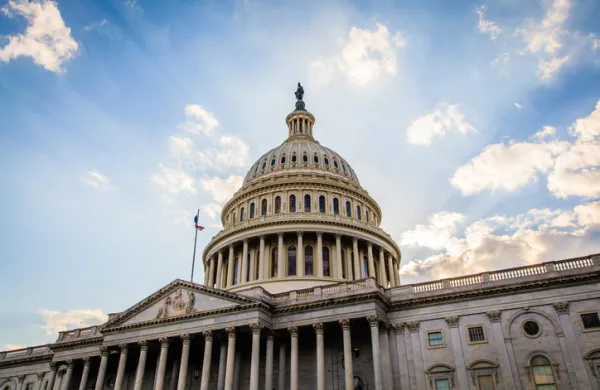On August 1 the U.S. Senate Committee on Environment and Public Works held the chamber’s first hearing on climate change in more than three years. Among those called to testify was John Griffin, secretary of the Maryland Department of Natural Resources. Griffin spoke about his state’s “long running efforts to research, plan and prepare for the impact of sea level rise, extreme storms and climate change.”
The state’s efforts date back to the early 1990s when the Department of Natural Resources teamed up with the University of Maryland Center for Environmental Science to research the impact of rising sea levels on costal communities and marsh systems within the Chesapeake Bay.
In the years since, however, one has hardly needed a scientist to see the impact climate change has had on the scenic Maryland coastline. The state is currently losing approximately 580 acres a year to shore erosion. Already 13 Chesapeake Bay islands have been consumed by water. Approximately 5,000 acres of Blackwater National Wildlife Refuge, home to the largest natural population of Delmarva fox squirrels and, outside of Florida, the largest breeding population of American bald eagles on the East Coast, have been subsumed. And, in 2011 Hurricane Irene and Tropical Storm Lee hit the Maryland coast.
Griffin is not the only one sounding the alarm. Maryland State Treasurer Nancy Kopp is deeply troubled about climate change and its consequences on her state. So much so that she too is seeking ways to do something about it. “There is a shared sensitivity to the impact we are seeing in Maryland,” Kopp told Institutional Investor in an interview. “There is an awareness of the broad global impact of climate change.” That awareness extends to the $37.6 billion Maryland State Retirement and Pension System for which Kopp serves as chair to the 14-person board of trustees. Kopp says that members of the board as well as the pension investment staff share her awareness of the potential long-term impact of climate change on the value of the fund’s investments.
Among public pension funds in the U.S., the large California plans, the $239 billion California Public Employees' Retirement System and $152 billion California State Teachers' Retirement System have long been the most public and progressive when it comes to considering the impact of so-called ESG issues, that is the environment, social matters and corporate governance, on their investment portfolio. Increasingly they are not alone. And Maryland is at the vanguard of a host of other pension systems, as well as some foundations, endowments and sovereign wealth funds, grappling with these issues.
What makes Maryland stand out from some others — though it is not unique in this regard — is the impact the state’s own vulnerabilities have on government officials like Kopp and Griffin, who already see the clear and immediate impact of climate change both on peoples’ day-to-day lives and the bottom line. Yet officials in other states may see that as well if the effects of climate change spread and intensify. As Griffin told the Senate hearing, “due to the observed and increasing future risk that a changing climate poses to Maryland’s citizens, ecosystem and infrastructure, our state is increasingly focused on addressing greenhouse gas emissions and preparing for the impact of climate challenge.”
Much more difficult to assess is the fundamental question of the economic impact of climate change, and how a pension fund like the Maryland State Retirement and Pension System can protect itself against it.
The first challenge is to measure the risks. As Kopp says, “First you have got to be aware of the extent of the problems that are out there.” There is plenty of work being done in this area, but more data is becoming available and more is being done with that information.
Take the example of carbon emissions and how the cost of emissions will be born by companies, either through some kind of tax, a carbon trading system (where corporations will buy and trade carbon credits) or business impact. A 2011 white paper produced by the foundation affiliated with Generation Investment Management — the London-based asset management firm founded by former vice president Al Gore and former Goldman Sachs Asset Management head David Blood that focuses on sustainable investing — applies the term “stranded assets” to the unpaid cost of carbon on corporate balance sheets. And the former head of risk at Goldman, Robert Litterman, published the white paper, "Pricing Climate Change Risk Appropriately," in the September/October 2011 issue of the Financial Analysts Journal. In it, and in subsequent research, Litterman has argued that the balance-sheet risk of climate change is far greater today than is often appreciated by the market and investors.
Meanwhile, a group of pension funds and other asset owners working with Ceres,a Boston-based non-profit that serves as an advocate for institutional investors and others on issues of sustainability, lobbied the Securities and Exchange Commission to request that publicly traded companies disclose material information about the impact of climate change on their operations in their financial reports. In 2010, the SEC issued groundbreaking interpretive guidelines on corporate disclosure and climate risk.
In May of this year, Ceres, along with the international relief organization Oxfam America and the Bethesda, Maryland–based sustainability focused investment manager Calvert Investments, produced a report entitled "Physical Risks from Climate Change," a guide for companies and investors on disclosure and management of climate impacts that argues in favor of greater corporate disclosure of risks associated with climate change. These investors argue that greater disclosure is still necessary both in the U.S. and elsewhere.
Up to now, institutional investors have mostly sought to address climate change and other environmental concerns with corporations whose shares they hold through shareholder engagement. That is the approach favored by Maryland along with other large U.S. public funds. Besides CalPERS and CalSTRS, those include the New York State Common Retirement Fund, the New York City Pension Funds, the North Carolina Retirement Systems, the Florida State Board of Administration and the Connecticut Retirement Plans and Trust Funds.
They and other institutional investors typically seek to frame these discussions around risk and, potentially, profit as opposed to abstract notions of social or environmental good. “There is a whole set of assumptions that people often make when they hear terms like ESG and sustainability,” says Rob Lake, director of strategic development for the United Nations Principles of Responsible Investment, which brings together investors to address ESG concerns. In the U.S. those assumptions typically involve increased cost resulting from new regulations, rather than as an investment or profit-making opportunity as a result of new revenue opportunities as well as potential cost reductions. London-based Lake says that part of the job of shareholders here is to change that outlook.
But investors are starting to look at other ways to address the issue. Maryland was one of 16 significant institutional asset owners to take part in a Mercer Investment Consulting study on climate change and asset allocation. In February 2011 Mercer issued a report, "Climate Change Scenarios – Implications for Strategic Asset Allocation," which argued for the need to integrate the potential effects of climate change into strategic asset allocation modeling and found that “climate policy could contribute as much as 10 percent to overall portfolio risk.” The more challenging question of what to do about that risk largely remains unanswered.
Concerned asset owners are asking investment managers to pay attention to ESG matters. To date, investors worth a combined asset value in excess of $30 trillion have signed up to the UN PRI. In a 2011 progress report, the UN said that 81 percent of 198 signatory asset owners that responded to the UN PRI survey said they asked outside money managers about ESG concerns. Mercer has recently announced that it is assigning ESG ratings to managers across asset classes — the first major investment consultant to do so.
Maryland’s Kopp says the state pension fund is starting to talk to the money managers it works with about ESG matters and trying to get them “to make it clear to the companies that they want to see evidence that they are starting to analyze where they are taking the company” on these issues. But even in a state like Maryland, where the effects of climate change are apparent and government officials are responding, change takes time. “We are like a battleship in Maryland,” says Kopp, referring to the retirement fund and its pace of change. Other investors are taking matters a step further with allocations to managers who are, in some way, seeking to respond to or profit from environmental triggers. For example, CalPERS has developed a “green” private equity portfolio that focuses on solar, wind, bio fuels and energy efficiency, albeit with mostly mixed results. Other pension systems, including the North Carolina Retirement Systems, have reported success “greening” their real estate holdings. Kopp says Maryland is considering going this route. “We are looking at allocations of green energies and opportunities, and we are looking at a range of consultants and mangers.” Although Maryland has yet to decide in its favor, she says, “I think it is a very reasonable step to take.”
If the evidence generated from places like the Maryland coastline and the research of Litterman and others is anything to go by, more investors will be taking this step sooner or later.






